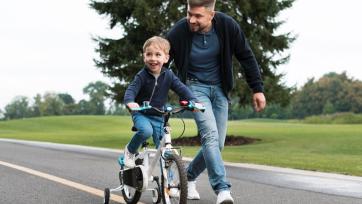Unlocking the world of writing for your toddler is a transformative journey filled with creativity and discovery. Teaching your little one to write not only lays the foundation for effective communication but also nurtures their fine motor skills and self-expression.

We'll explore how to guide your toddler through this exciting venture, emphasizing the importance of developmental readiness, creating a stimulating environment, and fostering a love for writing. Together, you and your child will embark on a rewarding path of early literacy and self-discovery.
The Developmental Journey Of Writing
Teaching your toddler to write is an exciting journey that aligns with their developmental stages. It's essential to understand these stages to tailor your teaching approach. Toddlers typically go through three phases: scribbling, drawing, and pre-writing skills. During the scribbling phase, children create random marks on paper, which is their first exploration of writing tools.
As they progress to the drawing phase, they begin to create recognizable shapes and figures. The pre-writing phase involves refining fine motor skills and practising controlled lines and shapes. Keep in mind that each child progresses uniquely, so patience is key in nurturing their writing journey.
Creating A Writing-friendly Environment
Fostering a writing-friendly environment is crucial to ignite your toddler's interest in writing. Set up a dedicated space with age-appropriate writing materials, such as crayons, markers, coloured pencils, and paper. Make sure the area is well-lit and comfortable for your child. Encourage exploration by providing a variety of writing tools, including washable markers, chalk, and even finger paints. Keep the environment positive and creative, allowing your toddler to express themselves freely through writing and drawing activities.
Fine Motor Skills Development
Fine motor skills are the building blocks of writing. Activities that enhance these skills are essential for your toddler's writing journey. Engage in activities like finger painting, playing with playdough, or using tweezers to pick up small objects. These activities help strengthen the muscles in their fingers and improve hand-eye coordination.
Additionally, colouring within lines, cutting with safety scissors, and playing with building blocks can contribute to fine motor skill development. Regular practice and age-appropriate challenges will help your toddler refine their hand movements, setting the stage for writing success.
Fun Writing Activities For Toddlers
Making writing enjoyable is key to keeping your toddler engaged in the learning process. Fun activities like finger painting allow them to explore writing without the constraints of precise lines. Finger painting lets them use their creativity freely and discover how different movements create various shapes and patterns.
Another engaging activity is tracing, where your child can trace over dotted lines or shapes. Sensory materials like rice or sand can also be used for tactile writing experiences. These activities make writing an exciting and multisensory adventure for your toddler.
Encouraging A Love For Language
Building a strong foundation for writing involves fostering a love for language and storytelling. Reading to your toddler regularly helps them develop a rich vocabulary and an understanding of the structure of stories and sentences. Encourage storytelling, whether through imaginative play or drawing pictures, to accompany their narratives. Incorporate language into daily routines, discussing daily activities, and asking open-ended questions. By creating a language-rich environment, you're nurturing the essential skills that underlie writing communication and creativity.
Teaching Proper Writing Grip
Teaching your toddler the correct writing grip is a fundamental step in their writing journey. A proper grip lays the foundation for control and precision in writing. Here's how you can help your child develop a correct writing grip:
● Model the Grip: Demonstrate the proper grip by holding a writing tool correctly. Use words like "pinch the pen" or "hold it like this" to explain the grip to your child.
● Use Age-Appropriate Tools: Begin with chunky writing tools designed for small hands. These tools are easier for toddlers to grasp correctly. As your child becomes more proficient, gradually introduce thinner writing instruments.
● Encourage the Pincer Grasp: The pincer grasp is a key developmental milestone. Encourage your child to use their thumb and index finger to hold the writing tool while the other fingers gently support it.
● Practice with Fun Activities: Engage in activities that promote the pincer grasp, like picking up small objects, using tweezers, or playing with building blocks. These activities help strengthen the fingers and refine the grip.
● Ergonomics and Comfort: Ensure that your child's writing tools are comfortable to hold. Avoid tools that are too large or too small, as they can strain the hand. Pay attention to ergonomics and choose tools that fit comfortably in your child's hand.
At What Age Should I Start Teaching My Toddler To Write?
While there's no set age, you can start introducing writing activities as early as 2-3 years old. Focus on exploration and creativity rather than formal writing skills. Progress will depend on your child's readiness.
How Can I Motivate My Toddler To Enjoy Writing Activities?
Make writing fun and engaging by using colourful materials, encouraging creativity, and participating in activities together. Praise their efforts and display their creations, celebrating their achievements.
What If My Toddler Doesn't Seem Interested In Writing?
If your toddler isn't showing interest, don't force it. Provide opportunities for exploration without pressure. Keep the writing materials accessible, and they may naturally develop an interest over time.
Should I Correct My Toddler's Writing Or Let Them Be Creative?
While it's essential to encourage creativity initially, you can gently introduce correct writing grip and techniques as your toddler shows readiness. Balance creativity with skill development.
Are Electronic Writing Tools Suitable For Toddlers?
Traditional writing tools are generally recommended initially as they promote fine motor skills and sensory experiences. As your child progresses, you can introduce age-appropriate electronic writing tools as supplementary learning aids.
Conclusion
Teaching your toddler to write is a rewarding journey that encompasses their developmental stages, fine motor skill development, and a love for language. Nurturing their creativity, providing engaging writing activities, and creating a writing-friendly environment are essential steps.
Remember that every child progresses uniquely, so patience and encouragement are paramount. By making writing enjoyable and age-appropriate, you set the stage for your toddler's writing success and foster a lifelong love for expressing themselves through words and drawings.



